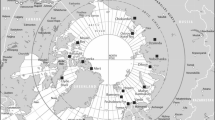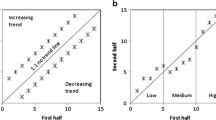Abstract
This paper presents techniques for studying the influence of the climatic and other variables for the explanation of the water use with an example of time series in Gainesville, Florida. A statistical methodology is described for separating the different time scale components in time series of water use, namely, long term component, seasonal component, and short term component. We analyze each component separately and we prove that the temperature, precipitation, soil temperature, and relative humidity time series are the main climatic factors for the explanation of the long term, seasonal and short term component of the water use time series. Part of the residuals derived from the linear regression of the long term component of the water use can be explained by the unemployment rate. We also show that with the decomposition of the water use time series the explanation of the water use has been improved approximately two times. The explanation of the long term component of water use by the long term regional weather parameters can enable us to the long term regional prediction of the water resources availabilities. This methodology can be applied for studying the water use time series in other locations, as well.
Similar content being viewed by others
References
Close B, Zurbenko I (2011) Kolmogorov–Zurbenko adaptive algorithm. In: JSM proceedings, statistical computing and analysts section
Eskridge RE, Ku JU, Porter PS, Rao ST, Zurbenko I (1997) Separating different scales of motion in time series of meteorological variables. Bull Am Meteorol Soc 78: 1473–1483
Hogrefe C, Rao ST, Zurbenko IG, Porter PS (2000) Interpreting the information in ozone observations and model predictions relevant to regulatory policies in the Eastern United States. Bull Am Meteorol Soc Bulletin 81: 2083–2106
Horbelt S, Munoz Barrutia A, Blu T, Unser M (2000) Spline kernels for continuous-space image processing. In: Proceedings of the twenty fifth IEEE international conference on acoustics, speech and signal processing (ICASSP), Istanbul, Turkey, pp 2191–2194
Maidment D, Parzen E (1984) Cascade model of monthly municipal water use. Water Resour Res 20: 15–23
Maidment D, Miaou SP (1986) Daily water use in nine cities. Water Resour Res 22: 845–851
Mays LW, Tung YK (1992) Hydrosystems engineering and management. McGraw-Hill, New York
OECD (2005) Data and metadata reporting and presentation handbook, OECD, Paris, section 4: guidelines for the reporting of different forms of data
Rao ST, Zurbenko IG (1994) Detecting and tracking changes in ozone air quality. J Air Waste Manag Assoc 44: 1089–1092
Rao ST, Zurbenko IG, Neagu R, Porter PS, Ku JY, Henry RF (1997) Space and time scales in ambient ozone data. Bull Am Meteorol Soc 78: 2153–2166
Tsakiri KG, Zurbenko IG (2008) Destructive effect of the noise in principal component analysis with application to ozone pollution. In: JSM proceedings, statistical computing section. American Statistical Association, Alexandria, pp 3054–3068
Tsakiri KG, Zurbenko IG (2009) Model prediction of ambient ozone concentrations. In: JSM proceedings, statistical computing section. American Statistical Association, Alexandria, pp 3054–3068
Tsakiri KG, Zurbenko IG (2010a) Prediction of ozone concentrations using atmospheric variables. J Air Qual Atmos Health. http://www.springerlink.com/content/14512x4012271724/
Tsakiri KG, Zurbenko IG (2010b) Determining the main atmospheric factor on ozone concentrations. J Meteorol Atmos Phys 109:129–137. http://www.springerlink.com/content/h21005561l0n673j/
Tsakiri K, Zurbenko IG (2011) Effect of noise in principal component analysis. J Stat Math 2:40–48. ISSN: 0976-8807 & E-ISSN: 0976-8815
Unser M, Aldroubi A, Eden M (1993) B-spline signal processing: Part I-theory and Part II-efficient design. IEEE Trans Signal Proc 41: 821–848
Webb AR (1996) An approach to non-linear principal component analysis using radially symmetric kernel functions. McGraw-Hill, New York pp 159–168
Wikipedia (2010) Kolmogorov–Zurbenko Filters. http://en.wikipedia.org/wiki/Kolmogorov%E2%80%93Zurbenko_filter
Yang W, Zurbenko I (2006) kzft: Kolmogorov–Zurbenko Fourier transform and application, R package
Yang W, Zurbenko I (2010a) Nonstationarity Wiley interdisciplinary revives. In: Proceedings of computational statistics, Wiley 2, pp 107–115
Yang W, Zurbenko I (2010b) Kolmogorov–Zurbenko filters, Wiley interdisciplinary revives. In: Proceedings of computational statistics, Wiley 2, pp 340–351. http://wires.wiley.com/WileyCDA/WiresArticle/wisId-WICS71.html
Zurbenko IG (1986) The spectral analysis of time series. North Holland Series in Statistics and Probability, Amsterdam
Zurbenko IG, Sowizral M (1999) Resolution of the destructive effect of noise on linear regression of two time series. Far East J Theor 3: 139–157
Zurbenko IG, Cyr DD (2011) Climate fluctuations in time and space. Clim Res 46:67–76. http://www.int-res.com/abstracts/cr/v46/n1/p67-76/
Author information
Authors and Affiliations
Corresponding author
Additional information
Handling Editor: Ashis SenGupta.
Rights and permissions
About this article
Cite this article
Tsakiri, K.G., Zurbenko, I.G. Explanation of fluctuations in water use time series. Environ Ecol Stat 20, 399–412 (2013). https://doi.org/10.1007/s10651-012-0225-0
Received:
Revised:
Published:
Issue Date:
DOI: https://doi.org/10.1007/s10651-012-0225-0




